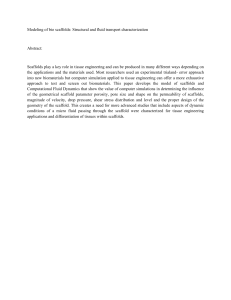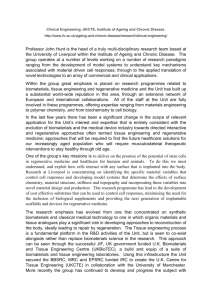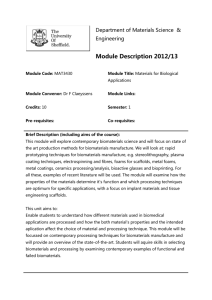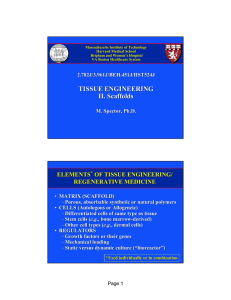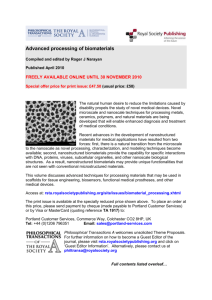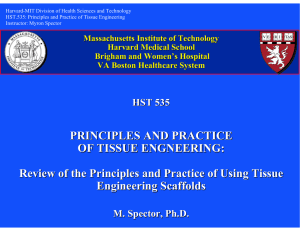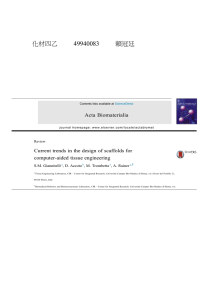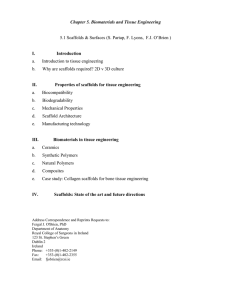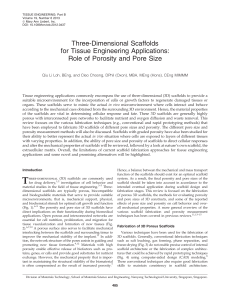Biomaterials - Tissue Interactions
advertisement
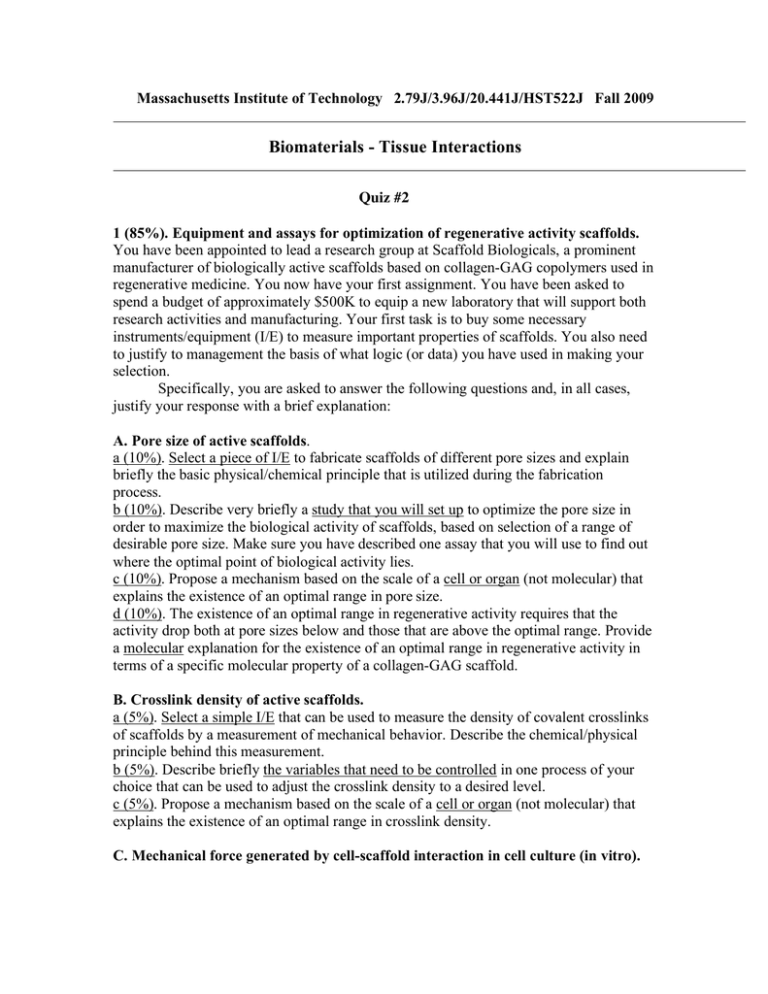
Massachusetts Institute of Technology 2.79J/3.96J/20.441J/HST522J Fall 2009 Biomaterials - Tissue Interactions Quiz #2 1 (85%). Equipment and assays for optimization of regenerative activity scaffolds. You have been appointed to lead a research group at Scaffold Biologicals, a prominent manufacturer of biologically active scaffolds based on collagen-GAG copolymers used in regenerative medicine. You now have your first assignment. You have been asked to spend a budget of approximately $500K to equip a new laboratory that will support both research activities and manufacturing. Your first task is to buy some necessary instruments/equipment (I/E) to measure important properties of scaffolds. You also need to justify to management the basis of what logic (or data) you have used in making your selection. Specifically, you are asked to answer the following questions and, in all cases, justify your response with a brief explanation: A. Pore size of active scaffolds. a (10%). Select a piece of I/E to fabricate scaffolds of different pore sizes and explain briefly the basic physical/chemical principle that is utilized during the fabrication process. b (10%). Describe very briefly a study that you will set up to optimize the pore size in order to maximize the biological activity of scaffolds, based on selection of a range of desirable pore size. Make sure you have described one assay that you will use to find out where the optimal point of biological activity lies. c (10%). Propose a mechanism based on the scale of a cell or organ (not molecular) that explains the existence of an optimal range in pore size. d (10%). The existence of an optimal range in regenerative activity requires that the activity drop both at pore sizes below and those that are above the optimal range. Provide a molecular explanation for the existence of an optimal range in regenerative activity in terms of a specific molecular property of a collagen-GAG scaffold. B. Crosslink density of active scaffolds. a (5%). Select a simple I/E that can be used to measure the density of covalent crosslinks of scaffolds by a measurement of mechanical behavior. Describe the chemical/physical principle behind this measurement. b (5%). Describe briefly the variables that need to be controlled in one process of your choice that can be used to adjust the crosslink density to a desired level. c (5%). Propose a mechanism based on the scale of a cell or organ (not molecular) that explains the existence of an optimal range in crosslink density. C. Mechanical force generated by cell-scaffold interaction in cell culture (in vitro). a (5%). Select an I/E that can be used to measure mechanical forces generated by cells in contact with a scaffold in culture. Briefly describe the physical/chemical/biological principle that underlies force generation. b (10%). Describe a series of measurements that can be used to decide whether cells generate forces independently of each other or whether they act cooperatively. c. (5%). Briefly, what is the significance of studying cooperative cell-cell behavior in the area of regenerative medicine? d (10%). Based on the statistical mechanical model of cell-cell cooperativity described in class, what is the minimum number of other cells that a given cell must cooperate with in order for the entire cell assembly to behave in a cooperative manner? 2. (15%) Evaluation of polymeric biomaterials for their ability to absorb a protein. A start-up company is interested in developing polymeric biomaterials that have the capability to bind a specific protein, lubricin (L), which is the principal lubricating protein in the body. In order to test their candidate biomaterials they have conjugated (i.e., permanently attached) lubricin molecules to gold particles (Fig. 1a), so that they can measure the amount of gold on the surface as a measure of the amount of lubricin. You can assume that the conjugation of lubricin to the gold nanoparticles has no effect on the lubricin molecular confirmation. The adsorption curves in Fig. 1b were the result of an experiment in which 2 candidate biomaterials were immersed into solutions of increasing lubricin concentration, after which the amount of gold on the surface was analyzed. A) Based on the curves in Fig. 1b would you recommend the selection of A or B based on the binding affinity and number of binding sites for lubricin? Explain. B) In order to check the uniformity of the binding sites on the surfaces of the biomaterials, one of the consultants has proposed using light microscopy to examine the distribution of the gold particles on the surfaces after the adsorption test. Would you agree with this method for visualizing the gold particles on the surface; if not what other microscopy method would you suggest? C) Another consultant has proposed that x-ray photoelectron spectroscopy, XPS (also referred to as ESCA), which can easily identify gold, be used as the method of determining the amount of gold on the surface of the biomaterials in these adsorption tests. Do you agree? 100nm Lubricin, L Gold particle a A Amount of Gold on the Surface b B [L] Fig. 1. (a) A protein, lubricin (L), conjugated to (i.e., permanently fixed to) a gold particle. (b) Adsorption curves for the gold nanoparticle-conjugated lubricin on two biomaterial surfaces (A and B) versus the concentration of lubricin in the solution. MIT OpenCourseWare http://ocw.mit.edu 20.441J / 2.79J / 3.96J / HST.522J Biomaterials-Tissue Interactions Fall 2009 For information about citing these materials or our Terms of Use, visit: http://ocw.mit.edu/terms.
